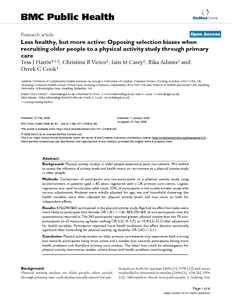Harris, TJ; Victor, CR; Carey, IM; Adams, R; Cook, DG
(2008)
Less healthy, but more active: Opposing selection biases when recruiting older people to a physical activity study through primary care.
BMC PUBLIC HEALTH, 8 (182).
ISSN 1471-2458
https://doi.org/10.1186/1471-2458-8-182
SGUL Authors: Carey, Iain Miller Cook, Derek Gordon Harris, Teresa Jane
![[img]](https://openaccess.sgul.ac.uk/541/1.hassmallThumbnailVersion/1471-2458-8-182.pdf)  Preview |
|
["document_typename_application/pdf; charset=binary" not defined]
Published Version
Download (215kB)
| Preview
|
Abstract
BACKGROUND: Physical activity studies in older people experience poor recruitment. We wished to assess the influence of activity levels and health status on recruitment to a physical activity study in older people.
METHODS: Comparison of participants and non-participants to a physical activity study using accelerometers in patients aged > or = 65 years registered with a UK primary care centre. Logistic regression was used to calculate odds ratios (OR) of participants in the accelerometer study with various adjustments. Analyses were initially adjusted for age, sex and household clustering; the health variables were then adjusted for physical activity levels and vice versa to look for independent effects.
RESULTS: 43%(240/560) participated in the physical activity study. Age had no effect but males were more likely to participate than females OR 1.4(1.1-1.8). 46% (76/164) of non-participants sent the questionnaire returned it. The 240 participants reported greater physical activity than the 76 non-participants on all measures, eg faster walking OR 3.2(1.4-7.7), or 10.4(3.2-33.3) after adjustment for health variables. Participants reported more health problems; this effect became statistically significant after controlling for physical activity, eg disability OR 2.4(1.1-5.1).
CONCLUSION: Physical activity studies on older primary care patients may experience both a strong bias towards participants being more active and a weaker bias towards participants having more health problems and therefore primary care contact. The latter bias could be advantageous for physical activity intervention studies, where those with health problems need targeting.
| Item Type: |
Article
|
| Additional Information: |
© 2008 Harris et al; licensee BioMed Central Ltd.
This is an Open Access article distributed under the terms of the Creative Commons Attribution License (http://creativecommons.org/licenses/by/2.0), which permits unrestricted use, distribution, and reproduction in any medium, provided the original work is properly cited. |
| Keywords: |
Aged, Aged, 80 and over, Cluster Analysis, Exercise, Female, Great Britain, Health Promotion, Health Status Indicators, Humans, Logistic Models, Male, Patient Selection, Primary Health Care, Questionnaires, Selection Bias, Science & Technology, Life Sciences & Biomedicine, Public, Environmental & Occupational Health, COST-EFFECTIVENESS, GENERAL-PRACTICE, CONTROLLED-TRIAL, EXERCISE, QUESTIONNAIRES, PARTICIPATION, INTERVENTIONS, PREVALENCE, DEPRESSION, PROMOTION |
| SGUL Research Institute / Research Centre: |
Academic Structure > Population Health Research Institute (INPH) |
| Journal or Publication Title: |
BMC PUBLIC HEALTH |
| ISSN: |
1471-2458 |
| Related URLs: |
|
| Dates: |
| Date | Event |
|---|
| 27 May 2008 | Published |
|
| Web of Science ID: |
WOS:000256680600001 |
  |
Download EPMC Full text (PDF)
|
 |
Download EPMC Full text (HTML)
|
| URI: |
https://openaccess.sgul.ac.uk/id/eprint/541 |
| Publisher's version: |
https://doi.org/10.1186/1471-2458-8-182 |
Statistics
Item downloaded times since 30 Apr 2012.
Actions (login required)
 |
Edit Item |



